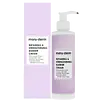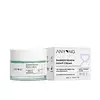What's inside
What's inside
 Key Ingredients
Key Ingredients

 Benefits
Benefits

 Concerns
Concerns

 Ingredients Side-by-side
Ingredients Side-by-side

Water
Skin ConditioningPanthenol
Skin ConditioningGlycerin
HumectantNiacinamide
SmoothingButyrospermum Parkii Butter
Skin ConditioningCeramide NP
Skin ConditioningSodium Hyaluronate
HumectantBifida Ferment Lysate
Skin ConditioningAllantoin
Skin ConditioningSqualane
EmollientSodium PCA
HumectantLecithin
EmollientInulin Lauryl Carbamate
Emulsion StabilisingPotassium Cetyl Phosphate
EmulsifyingButylene Glycol
HumectantCaprylyl Glycol
EmollientEthylhexylglycerin
Skin ConditioningCaprylic/Capric Triglyceride
MaskingCyclopentasiloxane
EmollientDimethiconol
EmollientSodium Hydroxide
BufferingPhenoxyethanol
PreservativeXanthan Gum
EmulsifyingTetrasodium EDTA
Water, Panthenol, Glycerin, Niacinamide, Butyrospermum Parkii Butter, Ceramide NP, Sodium Hyaluronate, Bifida Ferment Lysate, Allantoin, Squalane, Sodium PCA, Lecithin, Inulin Lauryl Carbamate, Potassium Cetyl Phosphate, Butylene Glycol, Caprylyl Glycol, Ethylhexylglycerin, Caprylic/Capric Triglyceride, Cyclopentasiloxane, Dimethiconol, Sodium Hydroxide, Phenoxyethanol, Xanthan Gum, Tetrasodium EDTA
Water
Skin ConditioningPseudozyma Epicola/Camellia Sinensis Seed Oil Ferment Extract Filtrate
HumectantGlycerin
HumectantPropylene Glycol
HumectantBifida Ferment Filtrate
Skin ConditioningEctoin
Skin ConditioningCoco-Caprylate/Caprate
EmollientLactobacillus Ferment Lysate
Skin ConditioningMacadamia Integrifolia Seed Oil
Skin ConditioningInulin Lauryl Carbamate
Emulsion StabilisingPanax Ginseng Root Extract
EmollientCalendula Officinalis Flower Oil
MaskingRosmarinus Officinalis Leaf Extract
AntimicrobialVaccinium Myrtillus Fruit Extract
Skin ConditioningHelianthus Annuus Seed Oil
EmollientSodium Stearoyl Glutamate
CleansingPanthenol
Skin ConditioningGlycine Soja Sterols
EmollientSorbitol
HumectantBakuchiol
AntimicrobialPentylene Glycol
Skin ConditioningAcrylates/C10-30 Alkyl Acrylate Crosspolymer
Emulsion StabilisingPhospholipids
Skin ConditioningSafflower Oil/Palm Oil Aminopropanediol Esters
Skin ConditioningCopper Tripeptide-1
Skin ConditioningMicrococcus Lysate
Skin ConditioningCaprylyl Glycol
Emollient1,2-Hexanediol
Skin ConditioningHeptapeptide-6
Skin ConditioningWater, Pseudozyma Epicola/Camellia Sinensis Seed Oil Ferment Extract Filtrate, Glycerin, Propylene Glycol, Bifida Ferment Filtrate, Ectoin, Coco-Caprylate/Caprate, Lactobacillus Ferment Lysate, Macadamia Integrifolia Seed Oil, Inulin Lauryl Carbamate, Panax Ginseng Root Extract, Calendula Officinalis Flower Oil, Rosmarinus Officinalis Leaf Extract, Vaccinium Myrtillus Fruit Extract, Helianthus Annuus Seed Oil, Sodium Stearoyl Glutamate, Panthenol, Glycine Soja Sterols, Sorbitol, Bakuchiol, Pentylene Glycol, Acrylates/C10-30 Alkyl Acrylate Crosspolymer, Phospholipids, Safflower Oil/Palm Oil Aminopropanediol Esters, Copper Tripeptide-1, Micrococcus Lysate, Caprylyl Glycol, 1,2-Hexanediol, Heptapeptide-6
 Reviews
Reviews

Alternatives
Ingredients Explained
These ingredients are found in both products.
Ingredients higher up in an ingredient list are typically present in a larger amount.
Caprylyl Glycol is a humectant and emollient, meaning it attracts and preserves moisture.
It is a common ingredient in many products, especially those designed to hydrate skin. The primary benefits are retaining moisture, skin softening, and promoting a healthy skin barrier.
Though Caprylyl Glycol is an alcohol derived from fatty acids, it is not the kind that can dry out skin.
This ingredient is also used as a preservative to extend the life of products. It has slight antimicrobial properties.
Learn more about Caprylyl GlycolGlycerin is already naturally found in your skin. It helps moisturize and protect your skin.
A study from 2016 found glycerin to be more effective as a humectant than AHAs and hyaluronic acid.
As a humectant, it helps the skin stay hydrated by pulling moisture to your skin. The low molecular weight of glycerin allows it to pull moisture into the deeper layers of your skin.
Hydrated skin improves your skin barrier; Your skin barrier helps protect against irritants and bacteria.
Glycerin has also been found to have antimicrobial and antiviral properties. Due to these properties, glycerin is often used in wound and burn treatments.
In cosmetics, glycerin is usually derived from plants such as soybean or palm. However, it can also be sourced from animals, such as tallow or animal fat.
This ingredient is organic, colorless, odorless, and non-toxic.
Glycerin is the name for this ingredient in American English. British English uses Glycerol/Glycerine.
Learn more about GlycerinWe don't have a description for Inulin Lauryl Carbamate yet.
Panthenol is a common ingredient that helps hydrate and soothe the skin. It is found naturally in our skin and hair.
There are two forms of panthenol: D and L.
D-panthenol is also known as dexpanthenol. Most cosmetics use dexpanthenol or a mixture of D and L-panthenol.
Panthenol is famous due to its ability to go deeper into the skin's layers. Using this ingredient has numerous pros (and no cons):
Like hyaluronic acid, panthenol is a humectant. Humectants are able to bind and hold large amounts of water to keep skin hydrated.
This ingredient works well for wound healing. It works by increasing tissue in the wound and helps close open wounds.
Once oxidized, panthenol converts to pantothenic acid. Panthothenic acid is found in all living cells.
This ingredient is also referred to as pro-vitamin B5.
Learn more about PanthenolWater. It's the most common cosmetic ingredient of all. You'll usually see it at the top of ingredient lists, meaning that it makes up the largest part of the product.
So why is it so popular? Water most often acts as a solvent - this means that it helps dissolve other ingredients into the formulation.
You'll also recognize water as that liquid we all need to stay alive. If you see this, drink a glass of water. Stay hydrated!
Learn more about Water